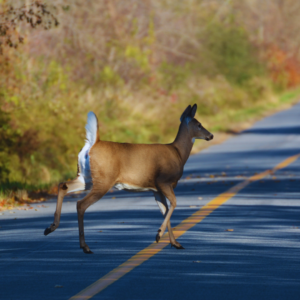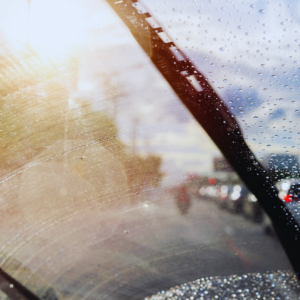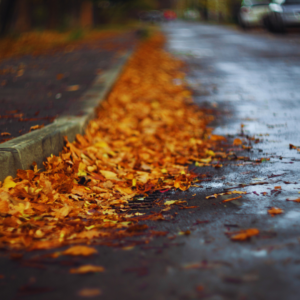Fall is a beautiful season, but it brings unique challenges for drivers. The changing weather, shorter days, and increased deer crossing and other wildlife activity can create driving hazards that may lead to accidents.
At Hammer’s Autoworks, we specialize in repairing vehicles after body damage, so we’ve seen firsthand how dangerous fall driving can be. Our goal is to help you stay safe on the road and avoid accidents.
Here are the key driving hazards to watch in the fall, along with tips on how to avoid potential body damage.
How Wet Leaves Can Create Driving Hazards
Fallen leaves are one of the most beautiful aspects of fall, but once they’re wet, they can become a hazard on the road.
Wet leaves are surprisingly slippery, similar to driving on ice, which can cause your vehicle to lose traction. This lack of control can lead to fender benders or even serious accidents.
How to Avoid It:
- Slow down when driving on roads covered in leaves, especially after rain.
- Increase the distance between you and the vehicle ahead of you to allow for safer stopping.
- Regularly check your tires for tread wear, as worn-out tires reduce your ability to stop quickly on slick surfaces.

Deer and Other Wildlife on the Move
Fall is mating season for deer, which makes them more active and likely to crossroads unexpectedly. Collisions with deer often result in significant auto body damage to the front end, hood, and even the windshield of your car.
How to Avoid It:
- Be especially cautious when driving during dawn and dusk, as deer are most active during these times.
- Flip on your high beams when on rural roads to increase your visibility.
- Slow down at deer crossing signs. These areas are so marked because deer are often spotted nearby. Also, if one deer crosses, expect more to follow.
- If a deer suddenly appears in front of you, brake firmly but avoid swerving, as this can lead to a more severe accident.
Fog and Reduced Visibility
Cooler fall mornings often bring fog and reduce visibility. When it’s harder to see cars, pedestrians, or other common obstacles, the likelihood of accidents, rear-end collisions, or side-swipes goes up.
How to Avoid It:
- Drive with low beams instead of high beams in foggy conditions. Rather than help you see, high beams can make visibility worse by reflecting off the fog.
- Slow down and give yourself more time to react to obstacles.
- Keep your windshield and windows clear of condensation by using your vehicle’s defogging system.
- Make sure your vehicle’s lights — headlights, taillights, and turn signals — are all working properly to make your vehicle more visible to others.

Sun Glare and Shorter Days
As the days grow shorter, sun glare can become more intense during the morning and evening hours. This sudden burst of light can momentarily blind drivers, leading to incidents such as rear-end accidents or hitting parked vehicles.
How to Avoid It:
- Always have a pair of sunglasses in your car to help reduce glare.
- Keep your windshield clean inside and out, as dirt and smudges can amplify the glare.
- Be extra cautious at intersections, as sun glare can obscure traffic signals or pedestrians.
Frosty Mornings and Slick Roads
As temperatures drop in the fall, frost can form on roads, especially bridges and overpasses. Frosty roads can be slick, leading to accidents like skidding into guardrails or other vehicles.
How to Avoid It:
- Reduce your speed when driving in early morning or late evening, when frost is most likely.
- Pay attention to shaded areas, as they are more likely to retain frost throughout the day.
- Ensure your windshield is clear before starting your drive. A frosted windshield can limit your visibility and reaction time.
Tire Maintenance: Essential for Fall Driving Safety
Your tires are always an important consideration in safe driving, and fall is no exception. Worn-out tires reduce your vehicle’s ability to grip the road, especially in wet or frosty conditions.
While tires are considered a mechanical component, your tires’ condition directly impacts your ability to avoid accidents that can result in body damage.
How to Avoid It:
- Regularly check your tires’ tread depth, as worn tires can increase stopping distance.
- Rotate your tires and make sure to keep them properly inflated to maximize performance.
- If you’re unsure about the condition of your tires, bring your vehicle to a trusted shop for an inspection.

Protect Your Vehicle from Body Damage with Hammer’s Autoworks
Fall driving comes with unique hazards, but by knowing what to look for, you can reduce the risk of accidents.
If you do find yourself in a collision, trust the experts at Hammer’s Autoworks to restore your vehicle to its pre-accident condition.
With our specialized body repair services, we’ll get you back on the road safely.
Schedule an appointment with Hammer’s Autoworks today for a free estimate. Let us take care of your vehicle’s body repair so you can enjoy the beauty of fall without worry.

